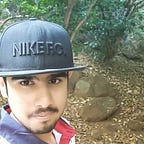Chat with jack on spatial audio
For this special edition I have interviewed Jack Daniel Gerrard who is a sound designer and sound engineer
His latest project A Jester’s tale is premiering in Sundance festival.
Which is a augmented reality experience in magic leap directed by Asad J Malik
The duo has worked together before on Terminal 3 which is an interactive AR documentary which turns viewers into custom officers at an airport terminal. So viewer can experience what is like to be a Muslim in foreign country
Here’s the short chat
1) What made you interested in AR?
To be honest, I had never really considered working with Augmented Reality until I met Asad. In September of 2017, Asad came to me proposing I work with him on his AR project, Asad and Assad. At the time, the extent of my knowledge of AR was “Pokémon Go”. However, as Asad explained the potential of Augmented Reality as a tool for social change, and the idea of “cultural displacement”, I started to understand how impactful this technology could really be. I agreed to work with him, and since I began working with him, have dived head first into the world of spatial sound.
With my education in Music and computer science, and brief experience with game design, I was quickly able to start producing some pretty cool things in Unity. The possibilities for spatial sound, especially in AR, are endless.
When thinking about Sound Design in Augmented Reality, the most important things to consider is the context. And I’m not talking about the context of the content, I’m referring to the way in which your music and sound can react to the physical context it is inhabiting. With the ability to scan the environment of the viewer that the Magic Leap and Hololense offer, you can assure that no viewer will ever hear the same thing twice. Does the music change at night? Does the diagetic sound abide by the rules of physics, or does it act in a completely alien way to the space? These are just a few of the aspects of AR sound that could never be explored with an MP3 file.
2) What are you doing right now?
Currently, I am living in North Adams Massachusetts continuing my work with 1RIC, both on the sound and music, and also on Unity development. We are currently in the production stage of our next project, so I’m working pretty much full time night and day.
3) Your background schooling college?
I began playing music when I was about 8 years old and when I joined the school band with my clarinet. I later picked up saxophone and Guitar, and began producing electronic music with some friends in High-school. Music and math have always been my favorite subjects, so when I was admitted to Bennington college, a small liberal arts school that encouraged working within multiple disciplines, I decided that that was my best option. It was from there I graduated in 2018 with a focus on Sound engineering and computer science.
4)How was your experience with the HoloLense and Magic Leap.
First off let me just say, that they are both incredible products in their own way. I am still amazed every day about how far this technology has come, and how quickly it is moving. That being said I would have to say I enjoy the Magic Leap much more.
One of the biggest perks about Magic leap, headset aside, is that they care about content. One of the biggest frustrations about working with the HoloLense was getting any kind of support from Microsoft. However Magic Leap picked up the slack in realizing AR’s potential as an artistic medium. Because of this, I expect to see a large surge of new augmented reality artists emerging in the coming months as Magic Leap becomes more readily available for the general population.
In regards to sound, both share similar properties in regards to what they can do, but once again I would have to say Magic Leap takes the cake. With all of its features more or less presented to you in an easy to use and understand set of sample scenes, it is incredibly easy to dive into things like hand tracking, and eye tracking, while on the HoloLense, these tasks felt a lot more daunting. However, the MagicLeap does not give you access to it’s built in speech recognition, while Microsoft just hands it right to you in a simple component, so I guess +1 for Microsoft there.
Overall, they are both great, and though magic leap may have the lead right now, with the upcoming release of the HoloLense 2, its dynasty may be short lived. Either way it is great to see some competition in the market.
5)Your plans for the future?
Well for my immediate future, my plans are to finish this project and hopefully blow everyone who sees it’s mind. But further than that, I hope to continue being on the cutting edge of technology, and finding new uses for sound that have yet to be imagined. I also have dreams of producing my own projects in the near future, whether with 1RIC, or as projects I take on on the side, seeing how these tools can be harnessed by the human imagine at the end of the day is one of my greatest passions.
